MS Pacific Star - A Review of the P&O Cruise Experience
Introduction
In summary, P&O cruising is pretty down market, although good value and good for families. This ship has long since gone from P&O's fleet but has been replaced by other ageing ships which have outlived their usefulness elsewhere. Most "new" ships entering P&O service here are around 20 years old (the "new" refers to the paint and the name) so don't expect to live like a sheik for the duration.
This page records some impressions of a cruise in October 2006, for the benefit of anybody contemplating doing something similar. The impressions recorded are probably still relevant to P&O's cruise experience and of course the places visited. For a ship well under half the size of others reviewed on this site, "Pacific Star" offered much better facilities for kids and higher hygiene standards; if this is still part of the P&O experience it may be good to know.
We booked late as a result of a phone call from a cruise-addict friend who said he had heard of a deal too good to refuse, so we took his word for it and didn't. The brochure price of our cabin was $3755 per person for the 11 night cruise with a "Price Breaker" price of $2440; some got it for under $1000. The first lesson, therefore, is not to buy from the brochure or too far ahead, unless you are determined to have the best cabin on the ship, or pay four times as much as the people in the one next door.
The official title of our cruise was "Sundrenched Dreams" which was about as close as we got to the real thing. Throughout the cruise we had mild temperatures, strong winds and moderate to rough seas (when outside the reefs); not P&O's fault, but unexpected none-the-less. I was glad to have a jumper which I had meant to leave in the car. Tropical Cyclone Xavier hit Luganville two days after we had left; a strong earthquake had hit the same area two days before we arrived.
The age demographic on the ship was quite wide, although there was a strong contingent of baby boomers and older. There were about 3 dozen small children; but not many in the 15-40 age group (although this may be a lot different in school holidays). The size demographic was even more interesting; a lot of grossly obese people, including some who must have had difficulty with the 610mm-wide cabin doors.
Cruise ships seem to be the last bastion of smokers, with parts of many of the public rooms set aside for them. Unfortunately the ship is only 24 metres wide, so the smell is hard to escape for the rest, even on the open decks. If you are a non-smoker, prepare to travel back in time as well.
Cruise ships carry a large number of people and you mightn't enjoy the experience if you don't like being part of a crowd. Many of the places visited are quite small and don't look like the brochure pictures when there are 1200 people on the beach. Expect to be embarrassed by fellow passengers who will want to have their photo taken pawing or merely standing beside any carving or totem without regard to its purpose or cultural significance (this also applies to locals who may occasionally appear, with or without "pets" and dressed in grass skirts or penis sheaths with the intention of charging you to take their photo).
The Ship

"Pacific Star" is of 35,000 tonnes gross and carries up to 1350 passengers, which makes it a fairly small ship by modern standards, less than half the size of the P & O and Princess vessels that currently ply Australian ports.
The ship is air-conditioned throughout (but this wasn't severely tested on our cruise) and has eight lifts as well as the three major stairwells.
Built in 1982 as Carnival's "Tropicale", the ship has been significantly refurbished prior to her rebirth as "Pacific Star" in 2006, with evidently new carpets throughout and new fittings in the cabins and public rooms. Interestingly, some of the decor around the place had a decidedly 60-ish feel (see photo of cabin). Refurbishment also included a re-modelling of the ship's stern (which makes my welding look pretty fancy). Somewhere along the way "Tropicale's" ugly whale tail funnel was replaced by a humungous stovepipe. As this is a European ship, open deck space is limited.
"Pacific Star" has two 10MW diesel engines which throb away down below and probably make this a noisier ship than one with modern gas turbines (or for that matter, old steam turbines). The ship seems to be well stabilised and rolled only slightly in rough seas, but likes to pitch a bit in a swell. It has a disconcerting tendency to shudder frequently in rough seas; I don't know what causes this.
Embarkation/Disembarkation
The ship arrived in Brisbane at 6am and was in port for only 8 hours, during which it had to disgorge 1200 passengers with their 40 tonnes of luggage, take on another 1200 with their 40 tonnes of luggage, and load a couple of hundred tonnes of provisions and a few hundred tonnes of fuel. The last passengers did not leave the ship until about 10:00am, and they were still shuffling through Customs when the next batch of passengers was told to arrive at 10:30am. Consequently the entire process was a complete shambles, with long queues for everything, chaotic traffic, and little chance of a cappucino to calm frayed nerves. This is all rather sad, because the cruise terminal was brand new at the time, and now services much larger ships.
Facilities
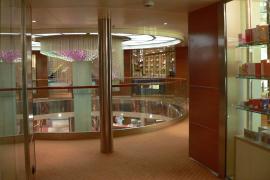
Purser's office and shore tours desk.
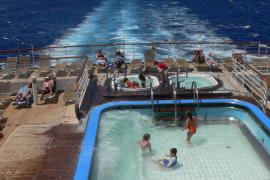
Promenade deck overlooks the
children's area at the stern.
The wading pool didn't get emptied
in rough weather!
Public rooms include a large dining room (with no windows, not too good if you're feeling queasy), a cafeteria, show lounge, two dance lounges (one of which doubles as a steakhouse/secondary resturant), and casino. Most of the above rooms have their own bars; there are two other bar lounges and a couple of bars on deck, so the grog is never far away.
There is a mostly enclosed promenade deck, parts of which are used as an internet cafe (7 computers) and for selling art and photos taken on the ship.
There are four small shops (duty free grog & mini-pharmacy, ship souvenirs, jewellery and cosmetics & perfume); unfortunately there is no laundry for the benefit of passengers.
On deck there are another two bars, and a 1.8 metre deep swimming pool which is small, and seems to get emptied at the slightest sign of any ship movement.
Kids are well catered for, with their own inside activity areas at the rear of the ship, adjoining a netted outer deck with an 0.4 metre deep splasher pool. Between this and the upper deck is a "family" area with an 0.7 metre deep wading pool and two spas. All pools are filled with seawater, so their temperature varies throughout the cruise.
Cabins
Cabins range from 4-berth inside cabins to verandah cabins, of which there are only ten. Because we booked late the two of us were in a four berth inside cabin; the top beds were folded up and the lower beds were pushed together to make a bed approaching king size width but only standard length.
Most cabins are very small; ours was only 2.4 metres wide and we had to get into bed over the end, because of the folded-up bunks. Outside cabins are slightly wider, but shorter. All have small ensuite with toilet, basin and shower. There is a TV, hair dryer and phone, but no other appliances.

(from door - wardrobes on the left,
ensuite door on the right)
Our cabin was on B deck near the funnel duct; the engine could be heard and the vibrations felt at all times. These were a bit intrusive when the ship was at cruising speed (19 knots); tonking around the islands at 8-12 knots seemed to be less of a problem.
We wouldn't take an inside cabin again, as there is no daylight to wake you up, and no way to know what sort of day it is or where you are, before you shower and go up on deck, only to find out that you've put on the wrong clothes and have to go down again anyway. The cruisecam can be accessed via the TV, but we didn't find this sort of weather assessment at all reliable. With no reference horizon, any movement of the ship feels worse than it probably is; not great if you're prone to sea-sickness. To offset all that, there is plenty of incentive to spend more time out of your cabin!
If you're half inclined to splash out for a verandah cabin, note that these overlook the Promenade deck below, and do not offer much privacy. They also are directly on top of the "Starlight Lounge", so you may need to like the music.
Dining
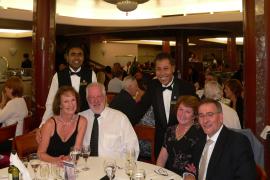
a-la-carte dining, with excellent service
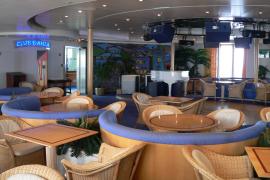
the nicest room on the ship, it
doubles as an evening steakhouse
but is otherwise under-utilised.
Evening dining in the Bordeaux Restaurant is in two sessions starting at 5:45pm and 8:00pm; your table is allocated for the cruise and you need to be on time. They like smart casual attire at all times but have a couple of so-called "formal" nights when ladies seem to get dressed up and men are expected to wear jackets. The restaurant is also open for breakfast and lunch, with open seating but restricted hours.
The Bahai Lounge steakhouse is only open for dinner and has to be booked; it carries a $20 per person surcharge.
The Lido Bistro is more fairly described as a cafeteria, it is bare and uninviting, and looks surprisingly tired in comparison to other public areas of the ship. It is open for all meals and just about all the time, if you are seeking something a bit more casual. There are also casual meals around the swimming pool.
A lot is said about the food on P&O cruises and certainly, there is no shortage of it. In the Bordeaux Restaurant there is a different menu every night, consisting of around four appetisers, one entree (usually pasta), around four main courses and as many desserts. The food is good without being excellent or exciting; alcohol has to be paid for but you can stretch a bottle of wine over a couple of nights if you want to. The food at the steakhouse we found to be much better, and worth the extra cost.
Service
The ship is run by a surprisingly small number of officers and senior managers in its 550 or so crew complement. Most of the remainder are Indonesians and Phillipinos, who work long hours (with no days off at sea) on a 6 month on - two months off basis. They seem generally happy with their lot, and the service is friendly, efficient and cheerful.
After the last port however, there seems to be some loss of interest with the current batch of passengers; it starts with small things (like the compendium being removed from the cabin), and you know you're past your use-by date when told to have your bags packed by 9pm on the last night of the cruise, and your cabin vacated by 6am.
Entertainment
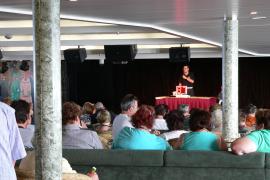
- bingo with everyone's favourite
Deputy Cruise Director
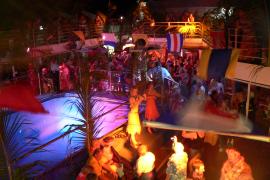
The ship has a staff of a dozen or more entertainers headed by a "Cruise Director". On our cruise he had a deputy who appealed to everyone with a mental age of under 10, but was extremely irritating to everyone else. The others ran various activities to keep us amused during the day, and sang and danced for us in the evening. The ship's 3-piece band "Muzzik Unlimited" has been described on the "Pacific Sky" as competent, but lacking passion, which seems pretty fair.
All of the entertainment seemed directed toward the older passengers, there was no disco and mostly old-time dancing in the Starlight Lounge. "Theme nights" which we had been led to expect didn't eventuate, unless you include an "Island Night" which was restricted to the upper deck after dinner, and turned out to be the only decent party for the whole cruise.
From time to time there are "art auctions" which feature for the most part limited editions and prints; the bloke who ran them sure knows how to work an audience, and my advice would be to stay away unless you know a lot about art.
A 4-page newsletter is delivered to cabins every night advising what's on for the next day, including information about places to be visited.
Costs
Your food on board (except the steakhouse), entertainment and shore transfers are covered by your fare, and tea/coffee is available free in the Lido Bistro 24/7. You have to pay for just about everything else:
- Drink prices are probably reasonable by Australian standards, but not cheap considering it is supposed to be duty-free. The ship's water supply is not recommended for drinking but this may only be a ruse to sell you bottled water at $3.50 a litre. Soft drinks are $2 a can, Australian beer $4.50 a stubbie, cocktails from $6.50 and wine mostly upwards of $20 a bottle. If you are planning a "booze cruise" it's going to cost you plenty.
- Laundry is $3 to $4 a garment, but wait for the specials when they offer a whole bag for $20 ($25 with ironing). Some of our ironing was pretty ordinary (shorts looked as though they had been sat on).
- Internet access $0.25 a minute. This is satellite based, so may be a lot slower than your ADSL at home.
- Items in the ship's shops were probably around 50-75% of what you would expect to pay in Australia (depending on the level of duty). Liquour was much cheaper in Port Vila, which most people seemed to know. Note that liquour bought ashore is taken off you on re-boarding, and not given back until disembarkation.
- Photographs which are taken of you will be offered for purchase from $15 per print.
P&O have a curious policy of debiting your cruise card $4.50 per day per person for "tipping" unless you expressly ask them not to, which I assume is their way of sustaining this annoying practice in an essentially cashless environment. I have always thought that tipping should be reserved for anyone giving exemplary service, and certainly not distributed generally and anonymously regardless of merit, so we cancelled ours straight away. They do, however, give you the opportunity to nominate crew members who deserve commendation through other schemes.
Health, Safety and Security
A lot of people in a small space is a good recipe for spreading disease, and P&O seem to be well aware of it. Whenever you enter a dining area or board the ship, your hands are squirted with an alcohol-based gel disinfectant; there is also considerable daily attention to handrails around the ship. You wonder if the crew are sufficiently trained to understand these procedures, however, if you observe the same cloth being used to wipe tables and floors alternately.
The Captain seemed to place considerable emphasis on the safety of passengers, cancelling one shore visit when the seas appeared too rough for the tenders to operate safely, and closing the open decks one night when the seas were particularly bad. We were a bit surprised therefore to see crewmen working on the lifeboat davits without safety harnesses (they put them on when working directly over the concrete wharf 20 metres below).
Top marks to P&O for security. On embarkation your luggage is taken away and x-rayed before delivery to your cabin. You are photographed and issued with a magnetic striped "cruise card", which is a combined ID card and credit card for everything that you need to pay for on the ship. You can only get on or off the ship with this card, so P&O know who is on the ship at all times. When you board the ship, your mug shot is displayed and someone makes sure it is really you, before x-raying your hand luggage and giving you the metal detector treatment just like at an airport.
The ship has about half a dozen security guards of its own who are highly visible at all times. A bunch of people who got a bit anti-social on the first day of our cruise were rapidly pulled into line and were hardly heard of for the remainder of the cruise.
There are security cameras in all public parts of the ship, including the open deck areas.
Ports
Our itinerary included three ports "alongside" and three island stops where passengers had to be taken ashore in the ship's tenders (enclosed lifeboats), although one of the latter stops was cancelled due to rough seas. A disadvantage of larger ships is that tender transfers seem to take a while, even at 90 or so people a time. We had to "take a ticket" when we were ready to go ashore, and wait an hour or so until our boatload was called; similarly there were some long queues for the tender to get back to the ship, even with four of them in the water.
Double-sided information sheets were available for all places visited. These included useful information on places to visit, culture, currency etc, but could have benefitted from better maps.
Ports were as follows:
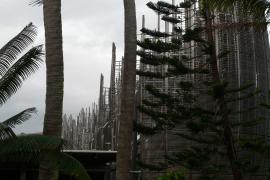
Noumea, New Caledonia.
Anyone expecting a little piece of Paris should stay on the ship; I've no idea why P&O seem to include this port in most of their itineraries. The town is very run down and we didn't see any decent shops, or fancy spending time in the dusty parks. We went on an organised excursion to the Tjibaou Cultural Centre, which was very grandiose on the outside although apparently designed without much regard to the climate, materials available, or intended function (a bit like the Sydney Opera House, to which it is compared). After showing us around the garden for an hour and giving us some orange drink, the guide advised that we were too late to see inside - P&O gave us our money back.
Update 2020: Noumea has been spruced up a bit; we found there are now "hop-on/hop-off" busses around the bays, a few trolley trains visiting major attractions, and a few decent shops. The Johnson Supermarket close to the wharf has a currency exchange machine which mugs unwitting tourists.
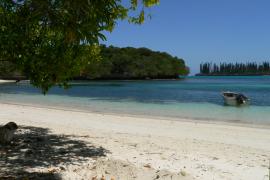
Des Pins (Isle of Pines), New Caledonia.
This is a lovely place, but scarcely big enough for an invasion of 1200 tourists. We went across a small spit to a double bay where they said the best snorkelling was. The beautiful but narrow sandy beach was a bit windy and it had made the water a bit murky too; the snorkelling was fairly ordinary for anyone who has been to the Great Barrier Reef or Coral Bay. It was more sheltered at the resort end of the beach further around, and at the beach where the tenders landed us. Next time I'll climb the hill; I'm sure the view is superb.
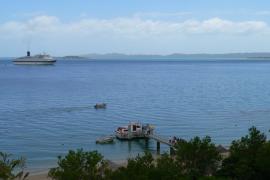
Emerald Bay (Divine Island), New Caledonia.
For Divine Island read "P&O Island", apparently used exclusively by the Company with support from the locals, who live on a larger island nearby. We had a BBQ lunch here prepared by the ship's cooks and served in shelters evidently constructed for the purpose. There is supposed to be a coral garden with underwater piped music; a few people found some coral "bommies" near the jetty but no-one heard any music, apart from the western music blaring out from a kiosk on the beach. We walked around the island in two hours; the beach is of coarse broken coral and shoes of some sort are needed. The locals had set up stalls of souvenir handicrafts but didn't seem to sell much; the kids had a day off school and played volleyball on the beach with some from the ship, before leaving via a tinnie shuttle service (with their schoolbags full of P&O fruit).
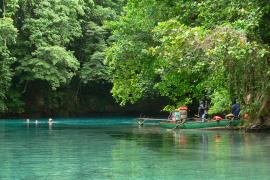
Luganville, Vanuatu.
The Americans had a big base here during WW2 and seem to have left most of their rubbish behind, including submerged wrecks of a US passenger liner and destroyer which they managed to sink with their own mines (I guess some things never change). We went on a short trip in a dugout canoe up the crystal clear Riri River, to a beautiful swimming hole fed by a volcanic spring - pure magic!
Lamen Bay, Vanuatu.
We anchored here for an hour or so but couldn't go ashore because of the rough conditions; it looked similar to the other island stops. I felt sorry for the locals who had gone to all the trouble of setting up for us, only to see us pull up anchor and leave.
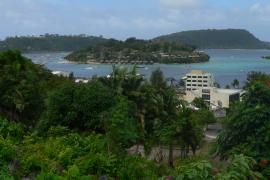
Port Vila, Vanuatu.
We arrived here early because of the aborted visit to Lamen Bay. It gave us the opportunity to have dinner ashore at the beautiful Vila Chaumieres restaurant on a lagoon, and get ripped off by a mad taxi driver, which apparently is fairly common (we were told that the $15 fare was normally $2, but none of the taxis have meters). The following day we hired a car and drove out to the Cascade Waterfall and some other spots, before getting our duty free liquour in the town (~AU$100 for 4 litres). AU$ and the local Vatu currency peacefully co-exist; there is no need to change any money and the ship's purser doesn't offer to anyway. Don't go expecting to see a great range of duty-free cameras or electronics, though!
The Vanuatu people are very friendly and this was a place we would come back to.
Update 2020: We did. This time we took a taxi from the wharf on a tour of local attractions (including beaches, waterfalls, a lagoon and a turtle sanctuary). The driver explained that Vanuatu has been largely taken over by the Chinese and tourist money only gets into the local economy via shops on the wharf, taxis and the local owners of the "attractions", most of which have entrance fees of $10-$20 per person. Take extra cash off the ship; everyone takes Australian Dollars so there is no need to convert it.
Interestingly, we weren't required to produce our passports for any of the shore visits; only our cruise card was needed to get off and on to the ship.
